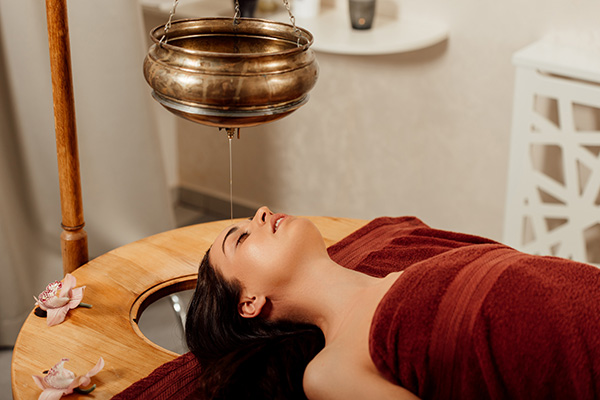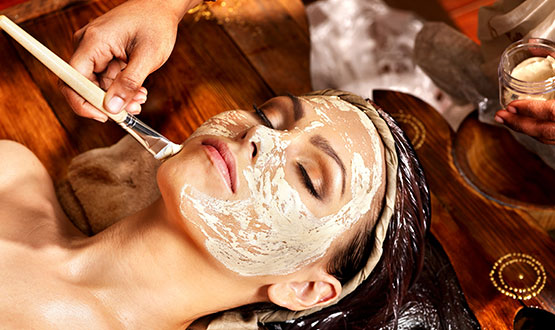Panchakarma Threatres
Emesis (VAMANA)

Vamana, a guided emesis procedure, facilitates the expulsion of accumulated toxins through controlled vomiting. It is most effectively practiced during late spring or early summer, a period known for Kapha aggravation, and preferably near the full moon when the water element is heightened. Optimal timing for the procedure includes one day after preparatory measures like snehana and svedhana, following a restful sleep, after complete digestion of food, and preferably between 6:00 to 9:00 or 10:00 a.m., aligning with the Kapha dominant time of day
Before the commencement of Panchakarma, the preliminary therapies, known as Purva Karma, play a crucial role in reducing excess doshas and eliminating ama (toxins) from the system. This process starts with consuming lightly spiced meals tailored to one's dosha constitution. Following the palliation therapies that rid the body of toxins, two primary preliminary therapies are employed: oleation and sweating. These therapies initiate the process of removing toxins that have accumulated and settled in inappropriate locations within the body, which are often the root cause of various health issues or imbalances.
Purgation (VIRECHANA),

Virechana, a purification therapy in Ayurveda, targets the elimination of excess Pitta primarily from the liver, gall bladder, and small intestine, bypassing the large intestine. Bitter purgatives are administered based on the specific concern. This therapy is particularly beneficial for Pitta and liver-related disorders, such as gallstones. As per the Ashtanga Hridayam, the ideal time for purgation is after Vamana (emesis) and post 9:00 a.m., marking the end of the Kapha period of the day. Prior to Virechana, preparatory treatments like Snehana and Svedana are administered, followed by the therapy itself.

Ayurveda emphasizes that the nose serves as the gateway to the head, making nasal herb therapy an effective approach for addressing diseases of the throat, neck, head, and sensory organs such as ears, nose, and eyes. Nasya therapy is also employed to tone and strengthen these areas, improving vision, smell, and hearing while preventing issues like greying hair, hair fall, stiff necks, headaches, and lockjaw. Administered before meals, nasyas are ideally taken in the morning on an empty stomach, with a recommendation to avoid them on cloudy days.

Basti therapy, a cornerstone of Ayurvedic treatment, targets the excess of Váyu (air or wind) in the body, either as a standalone therapy or when Váyu is the predominant deranged dosha. The term 'Basti' originates from Sanskrit, referring to the urinary bladder. Traditionally, larger animal bladders such as those from buffaloes and goats were utilized as enema bags for administering this therapy. By focusing on cleansing and toning the colon, which is intricately connected to all other organs and tissues, Basti therapy facilitates holistic healing and rejuvenation of the entire body. Given that the colon serves as the primary organ for nutrient absorption, maintaining its health and functionality is vital for proper assimilation of nutrients

Raktamokshana, a therapeutic procedure in Ayurveda, involves the controlled release of toxic blood from various sites in the body. This practice aims to eliminate impure blood, which is often the underlying cause of various skin and systemic illnesses. Typically, 2 to 8 ounces of blood is removed during the procedure. Bloodletting is particularly beneficial for achieving immediate results in Pitta disorders, including skin ailments, liver and spleen conditions, as well as issues like gout, headaches, and hypertension. The optimal time for performing Raktamokshana is late summer through early fall
Holistic vessel for Shirodhara

Shirodhara treatment is a therapeutic procedure rooted in Ayurveda that involves gently pouring a continuous stream of warm oil or other liquids gently on forehead, specifically targeting the “third eye” area. The term “Shirodhara” is derived from Sanskrit, where “Shiro” means head, and “Dhara” means flow. Shirodhara Therapy aims to balance the doshas—Vata, Pitta, and Kapha—while promoting mental clarity, relaxation, and overall well-being.
Ayurvedic steam bath

Benefits: The steam bath induces sweating, which helps to open up the pores, eliminate toxins, and cleanse the body of impurities. It also promotes circulation, relaxes muscles, relieves stiffness and tension, and rejuvenates the skin. Additionally, the inhalation of herbal steam can have therapeutic effects on the respiratory system, helping to clear congestion and improve breathing.
Beauty care theatre


An Welcome to Ayush Beauty Care Theatre, an oasis of beauty and wellness inspired by the ancient wisdom of Ayurveda. Nestled in the heart of Wayanad, our theatre offers a unique blend of traditional Ayurvedic practices and modern beauty techniques. Step into a world of natural elegance and rejuvenation, where every treatment is a celebration of your innate beauty and vitality.
From luxurious herbal facials to revitalizing Ayurvedic massages, our expert therapists craft bespoke experiences tailored to your skin type and concerns. Immerse yourself in the soothing aromas of Ayurvedic oils and herbs as you indulge in pampering rituals designed to nourish both body and soul. Discover the transformative power of Ayurveda and unlock your true radiance at Ayush Beauty Care Theatre. Let us guide you on a journey to holistic beauty and wellness, where timeless traditions meet contemporary luxury in perfect harmony.
Comfortable accommodation !
Discover tranquility and rejuvenation at Ayush Ayurveda Hospital, Wayanad! .
Our hospital offers cozy single
and double rooms at pocket-friendly prices. Experience comfort and
relaxation in every corner of our serene accommodations.




